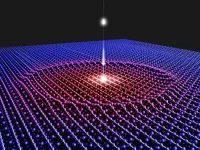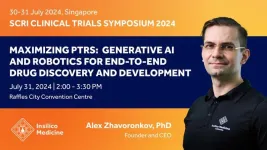(Press-News.org) July 26, 2024
Contact: Kate McAlpine, 734-647-7087, kmca@umich.edu; Nicole Casal Moore, 734-709-1651, ncmoore@umich.edu; Phillip Kisubika, 217-244-7448, pkk18@illinois.edu
Image
ANN ARBOR—He has honed the power of plasma to advance semiconductor processing, high-quality thin films for magnetic hard drives, and fusion energy. For these and other accomplishments, University of Illinois Professor David Neil Ruzic has been chosen to receive the 2024 University of Michigan Prize for Excellence in Plasma Science and Engineering.
Ruzic is the Abel Bliss Professor of Engineering in the Department of Nuclear, Plasma and Radiological Engineering at UIUC.
The annual international prize, established by the Michigan Institute for Plasma Science and Engineering and Michigan Engineering in 2023, honors a researcher, educator or manager for advances in plasma science and engineering that have or will significantly benefit society.
"With his rare mix of talents as a fundamental plasma scientist, remarkable educator and innovative entrepreneur, David has translated discoveries in basic plasma science into marketable solutions to improve microelectronics fabrication and advance clean fusion energy. In his work, which focuses on how plasma interacts with materials, he has bridged research and applications and provided societal benefit," said selection committee chair Thomas Mehlhorn, retired former superintendent of the Naval Research Laboratory's Plasma Physics Division, adjunct professor at the University of Michigan and MIPSE member.
Plasmas—ionized gasses that make up most of the ordinary matter in the universe—have long been of interest to scientists and engineers due to their unique properties. They can conduct electricity, respond to magnetic fields and produce chemically reactive environments at low temperatures. Today, they're used in medicine, manufacturing, microelectronics, sustainable technologies and space exploration, for example. Recent advances in fusion energy—the clean, sustainable process that powers the stars—have raised the profile of plasma science and engineering.
Ruzic is honored "for contributions to the investigation of plasma-material interactions having significant impact on the fields of EUV (extreme ultraviolet) lithography, thin films manufacturing and magnetic fusion," according to the award citation.
His work in extreme ultraviolet lithography—a cutting-edge semiconductor manufacturing technique—has been critical to bringing it to market to enable higher chip performance and efficiency. The approach, which relies on 13.5-nanometer wavelength light to create finer features and greater transistor density than previously possible, is now used by leading fabrication firms such as TSMC, Samsung and Intel.
Ruzic's contributions include developing EUV plasma sources and advancing techniques to keep the optics and lithography sources clean and free from contaminants throughout the manufacturing process, reducing costs and improving reliability.
In the field of thin films manufacturing, which is integral to nearly every step of semiconductor manufacturing, Ruzic optimized a technique known as plasma magnetron sputtering, enhancing the yield and uniformity of the films it produces. A startup he co-founded with postdoctoral researchers, Starfire Industries, translated the approach to commercial products. Today, it's the leading method for making high-quality thin films for magnetic memory devices such as commercial hard drives.
With regard to fusion energy, Ruzic developed an innovative way to use liquid lithium coatings on reactor walls to address a host of major obstacles in magnetic confinement fusion, one of two approaches vying to make fusion energy a reality. He demonstrated how a layer of flowing molten lithium could help hold temperatures down inside the reactor, protect the equipment and keep the plasma pure and stable. The work could pave the way for fusion power plants that are smaller and less expensive than other approaches could enable.
"Being chosen by my peers for this award is tremendous validation," Ruzic said. "I work across multiple plasma fields: fusion, magnetron sputtering, etching, EUV sources, and atmospheric-pressure plasmas. I had always worried that not specializing more deeply would dilute my impact. On the other hand, the cross-fertilization between those areas has allowed me to find connections and innovations that others may have missed. Awards like this make me feel much better about the path I chose."
Ruzic has been at UIUC since 1984 after receiving his Ph.D. in physics from Princeton University and conducting postdoctoral work at the Princeton Plasma Physics Laboratory. He is a fellow of the American Nuclear Society, American Vacuum Society, American Physical Society, and the International Society for Optics and Photonics. He has published more than 230 refereed journal papers, two books and six book chapters, and holds 11 patents. He has advised 37 Ph.D. students and 61 thesis master's students.
In 2020, he founded the Illinois Plasma Institute located in the UIUC Research Park, which is funded by industry to perform translational work and started a master's degree program in plasma engineering, which is closely coupled to industry. He is known on YouTube as Illinois EnergyProf with 83,000 subscribers and over 8.5 million views.
The Michigan Institute for Plasma Science and Engineering, sponsored by the University of Michigan, brings together plasma researchers from Michigan universities and the international community to investigate these fundamental plasma phenomena and translate advances in plasma science into society benefiting technologies.
END
Michigan Plasma prize honors University of Illinois professor
University of Michigan Institute for Plasma Science and Engineering celebrates David Ruzic's advances in plasma-aided semiconductor manufacturing and fusion
2024-07-26
ELSE PRESS RELEASES FROM THIS DATE:
Atomic 'GPS' elucidates movement during ultrafast material transitions
2024-07-26
UPTON, N.Y. — Scientists from the U.S. Department of Energy’s (DOE) Brookhaven National Laboratory have created the first-ever atomic movies showing how atoms rearrange locally within a quantum material as it transitions from an insulator to a metal. With the help of these movies, the researchers discovered a new material phase that settles a yearslong scientific debate and could facilitate the design of new transitioning materials with commercial applications.
This research, recently published in Nature Materials, marks a methodological achievement; the researchers demonstrated that a materials characterization technique called atomic pair distribution ...
UMBC scientists work to build “wind-up” sensors
2024-07-26
An international team of scientists, including two researchers who now work in the Center for Advanced Sensor Technology (CAST) at UMBC, has shown that twisted carbon nanotubes can store three times more energy per unit mass than advanced lithium-ion batteries. The finding may advance carbon nanotubes as a promising solution for storing energy in devices that need to be lightweight, compact, and safe, such as medical implants and sensors. The research was published recently in the journal Nature Nanotechnology.
Sanjeev Kumar Ujjain, from CAST, was a lead researcher on the work. He started the project while at Shinshu University, in Nagano, Japan, and continued after arriving ...
Researchers receive McKnight award to study the evolution of deadly brain cancer
2024-07-26
Scientist Dr. Aparna Bhaduri, assistant professor of medicine and biological chemistry, and neurosurgeon Dr. Kunal Patel, assistant professor of neurosurgery, both part of the UCLA Health Jonsson Comprehensive Cancer Center, have received the 2024 Neurobiology of Brain Disorders Award from the McKnight Endowment Fund for Neuroscience, which supports innovative research by U.S. scientists who are studying neurological and psychiatric diseases.
The award, $300,000 over the next three years, supports their efforts in gaining a deeper understanding of the microenvironment's role in shaping human glioblastoma, an aggressive type of brain cancer that is fast growing and difficult ...
Heather Dyer selected as the 2024 ESA Regional Policy Award Winner
2024-07-26
The Ecological Society of America (ESA) will present its 17th annual Regional Policy Award to Heather Dyer, Chief Executive Officer of the San Bernardino Valley Municipal Water District, Sunday, Aug. 4, 5:00 p.m. PDT, during the ESA Annual Meeting Opening Plenary. The ESA annual award recognizes an elected or appointed local policymaker whose record reflects the use of ecological science to inform policy decisions.
“ESA is honored to recognize Dyer,” said ESA President Shahid Naeem. “It’s rare for a biologist with ecosystems expertise to transition from technical science work to executive ...
New study disputes Hunga Tonga volcano’s role in 2023-24 global warm-up
2024-07-26
New research from a collaborative team featuring Texas A&M University atmospheric scientist Dr. Andrew Dessler is exploring the climate impact of the 2022 Hunga Tonga volcano eruption and challenging existing assumptions about its effects in the process.
The remarkable two-day event, which occurred in mid-January 2022, injected vast amounts of volcanic aerosols and water vapor into the atmosphere. Historically, large volcanic eruptions like Tambora in 1815 and Mt. Pinatubo in 1991 have led to significant cooling effects on the global climate by blocking sunlight with their aerosols. ...
Climate is most important factor in where mammals choose to live, study finds
2024-07-26
While human activity has had a massive effect on the natural world, a new study from North Carolina State University finds that climate is still the most influential factor in determining where mammals can thrive. The work sheds light on how climate change will affect wildlife populations.
Roland Kays, lead author of a paper on the work, said the study’s goal was to compare the importance of climate versus human factors in where mammals chose to live. To do so, researchers collected data on 25 mammal species from 6,645 locations across the United States. The study is one of the largest camera trap data analyses ever done. The data came ...
New study highlights global disparities in activity limitations and assistive device use
2024-07-26
A new study of over 175,000 people in 25 countries revealed that individuals in low- and middle-income countries face greater challenges with daily activities and are less likely to use assistive devices compared to those in high-income countries. These findings raise concerns about the global burden of disability, particularly in low-income countries.
Despite decreases in death and cardiovascular disease rates and increases in life expectancy worldwide, people in low- and middle-income countries still ...
Study finds targeting inflammation may not help reduce liver fibrosis in MAFLD
2024-07-26
Researchers at UCLA Health uncovered new information about the role inflammation plays in mitigating liver fibrosis, which is associated with metabolic-associated fatty liver disease (MAFLD), one of the most common diseases in the world affecting up to 40 percent of U.S. adults. While inflammation in the liver has long been considered a prerequisite to developing liver fibrosis, the scarring and thickening of tissue that can impair the liver’s ability to function, this new research suggests ...
Meet Insilico in Singapore: Alex Zhavoronkov PhD shares insights into various aspects of AI-powered drug discovery
2024-07-26
From July 30-31, Alex Zhavoronkov, PhD, founder and co-CEO of clinical stage artificial intelligence (AI)-driven drug discovery company Insilico Medicine will be attending SCRI Clinical Trials Symposium 2024 at Raffles City Convention Centre, and Brainstorm AI 2024: The New Race for AI at The Ritz-Carlton, Millenia Singapore, sharing strategic insights with global leaders across the technology and healthcare industries.
On 2:00 p.m, July 31, Alex Zhavoronkov PhD will be speaking at the session named “Methodologies and Considerations for ...
Insilico Medicine introduces Science42: DORA, the intelligent writing assistant for accelerated research
2024-07-26
Writing research papers is critical for disseminating scientific findings, but it does come with efficiency burdens, particularly for early-career researchers and non-native English speakers. A survey published in Nature in 2018 indicated that approximately 37% of respondents reported that they spend more than 20 hours a week on writing and revising scientific papers.
Recent progress in Natural Language Processing (NLP) technology, particularly with the rise of Generative Pre-trained Transformers (GPT) and other Large Language Models (LLMs), has equipped researchers with a powerful set of tools for processing extensive amounts of literature ...
LAST 30 PRESS RELEASES:
Scientists ID potential way to prevent brain injuries from triggering Alzheimer's
MASTER 2nd Open Call: Execution period kick-off
Algae for health in food and pharma
Advanced microrobots driven by acoustic and magnetic fields for biomedical applications
Chicago health information leader recognized for raising CPR readiness and blood pressure awareness
The Intimate Animal, a new book from Kinsey Institute Executive Director Dr. Justin Garcia
When blue-collar workers lose union protection, they try self-employment
New video dataset to advance AI for health care
MEA-based graph deviation network for early autism syndrome signatures in human forebrain organoids
New modeling approach sheds light on rare gut disease
Study documents potentially hazardous flame retardants in firefighter gear
Can certain bacteria regulate aging of the immune system and its related alterations?
AI model helps diagnose often undetected heart disease from simple EKG
There are fewer online trolls than people think
Cell membrane fluctuations produce electricity
Jeonbuk National University study shows positive parenting can protect adolescents against self-harm
Surface-engineered ZnO nanocrystals to tackle perfluoroalkyl substance contamination
This new understanding of T cell receptors may improve cancer immunotherapies
A new fossil face sheds light on early migrations of ancient human ancestor
A new immunotherapy approach could work for many types of cancer
A new way to diagnose deadly lung infections and save lives
40 percent of MRI signals do not correspond to actual brain activity
How brain-inspired algorithms could drive down AI energy costs
Gum disease may be linked to plaque buildup in arteries, higher risk of major CVD events
Contrails are a major driver of aviation’s climate impact
Structure of dopamine-releasing neurons relates to the type of circuits they form for smell-processing
Reducing social isolation protects the brain in later life
Keeping the heart healthy increases longevity even after cancer
Young adults commonly mix cannabis with nicotine and tobacco
Comprehensive review illuminates tau protein's dual nature in brain health, disease, and emerging psychiatric connections
[Press-News.org] Michigan Plasma prize honors University of Illinois professorUniversity of Michigan Institute for Plasma Science and Engineering celebrates David Ruzic's advances in plasma-aided semiconductor manufacturing and fusion



